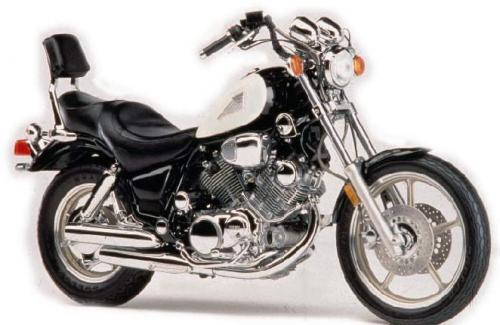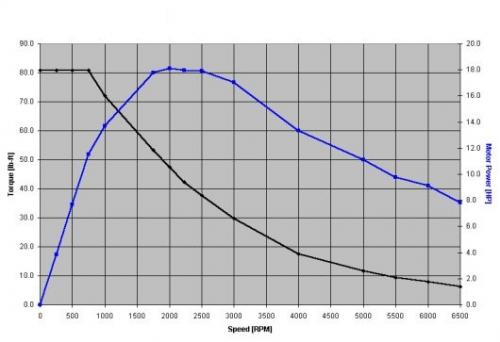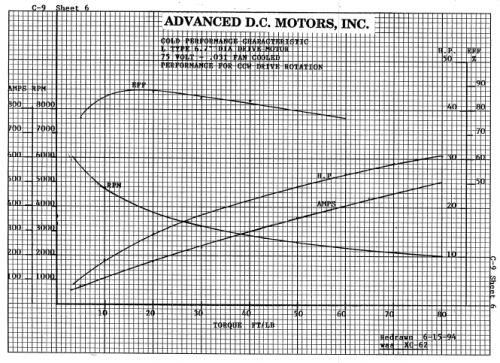Does anyone know if a conversion to electric has been tried on a Yamaha Virago?

I believe this bike might be an ideal candidate for the "conversion kit" idea Andrew posted at: http://visforvoltage.org/forum-topic/general/668-ideas-get-evs-road
Andrew wrote:
Another way is to refine a conversion plan. Then mass produce many of the parts that are needed. For example, I could manufacture 1000 aluminum motor mounting plates, controller mounting plates, charger mounting plates & brackets, ect for my motorcycle. Then someone could buy these and install them, along with the plans. The plans would not be general ideas, but specific step by step instructions. All components would be bolt on.
There are several reasons for this:
I had a look at used motorbike dealers and on ebay - there are plenty of old Viragos for sale in Australia and elsewhere.
They do not seem to go up in price once they get older like the BMW's I've also researched.
The XV535, XV1000 and XV1100 have a drive shaft, and some have double front disks.
They also come in smaller engine versions with chain drives. I am not sure how many frame sizes there are.
The engine looks large and heavy and frees up a large space for installation of batteries etc.
The tank is small.
There are very few electronics on the bikes to cause trouble.
Apparently they have some potential engine/carburettor/starter engine problems, excessive vibrations etc. but they are all related to components that would be removed for an electric conversion.
I have not found any reports of frequent problems that relate to frame or suspension of the Virago's, but it's early days in my research.
The frame is "unisex" - can be ridden by people of various sizes.
The overall shape of the bike looks like it lends itself to addition of streamlined fairings.
Mr. Mik




What do you think the gear reduction ratio for this Virago 1100 drive-shaft is?
Here is my guess: 25 cogs for the ring gear and 18 cogs for the pinion gear???
Making it about a 1:1.4 transmission?
2 O-ring
3 Oil seal
4 Shim(s)
5 Bearing
6 Ring gear
7 Thrust washer
8 Bearing
10 Guide collar
11 Bearing
12 Pinion gear
13 Shim(s)
14 Bearing
15 Bearing retainer
16 O-ring
18 Gear coupling
19 Driveshaft
20 Oil seal
21 Snap-ring
22 Snap-ring
23 Bearing
24 Universal joint
Mr. Mik
This information may be used entirely at your own risk.
There is always a way if there is no other way!
I am not sure how you calculated the gear ratio, but if you measure the size of the gears in the drawing the larger gear is 74 pixels and the smaller gear is 20 pixels. using this to guess the ratio I get 3.7 to 1 which sounds closer to the real thing. This is of course still a guess.
Grandpa Chas S.
Excellent idea to measure pixels, but I believe you measured from outside to outside.
The correct (or at least better) place to measure the diameter would be at the inner edge of the cogs, not the outer.
Using that I get about a ration of 1.9:1
Mr. Mik
This information may be used entirely at your own risk.
There is always a way if there is no other way!
Here's one I found:
http://www.evalbum.com/757
I was actually looking into one of the 250cc ones for my conversion. Unfortunately the frame is kind of small on the 250 for batteries, but it'd be easily possible to fit 20 amp batteries for a short-range conversion.
As far as the conversion kit idea, we had an interesting discussion in this thread: Rate of EV Adoption. JDH had the idea of decentralized manufacturing which is kind of what EV conversions are. They are assembled by the end user, but they could also be assembled by unskilled labor.
I don't think a production conversion kit is too great an idea. Conversions requires a lot of work to prepare the glider bike for the electrics including removal of the ICE components, and a lot of money and time in restoration. And, the frame was not designed for housing bulky batteries. I think that if one was going to source 1000s of parts for a conversion kit, they could also have a custom frame manufactured. Then they could setup a shop to just do the final assembly, or offer as an option to sell complete kits for a discount.
That seems like what Scott Cronk did with the EMB Lectra http://www.electricmotorbike.org . He was able to sell the bike pretty cheap, and he used a lot of standard components (sprockets, chain, brake components, tires, ect), so it was easy enough to buy parts.
Anyway, thats just my opinion. That's not to say a conversion kit couldn't work if it turns out there is a popular bike to convert. For now, there are so few motorcycle conversions being done that the market for a kit is small. And, its hard enough to find any decent donor bike for a good price, let along the exact make/model you are looking for.
[url=/forum-topic/motorcycles-and-large-scooters/587-my-kz750-electric-motorcycle-project]KZ750 Motorcycle Conversion[/url]
[url=/forum-topic/motorcycles-and-large-scooters/588-fixing-my-chinese-scooter]900 watt scooter[/url]
Pic from http://www.electri
Weeelll.. there are also custom parts on the Lectra. The frame is custom, the plastic body/fairing, the spedometer has an 'EMB' logo on it, etc. The brakes and wheels and tires, those are normal parts.
I recall that a couple years ago someone had a ??Voloci?? where the wheel broke. He needed a replacement wheel to get back on the road. Unfortunately the maker of the bike in question designed a nonstandard wheel and this guy went to lots and lots of trouble to locate a replacement wheel, and he ended up with the original maker who had one in his garage. So, yeah, it could be a problem if there were custom parts.
The equivalent in EV conversions are the kits to convert VW Rabbit or GEO Metro or Porsche 914 etc. Electro-Automotive did this, they saw there were lots of VW Rabbits on the road and did the work to make a standardized conversion kit specifically tuned to the VW Rabbit. As a result there are a lot of 96v Rabbit conversions based on that kit.
- David Herron, The Long Tail Pipe, davidherron.com, 7gen.com, What is Reiki
Andrew wrote: http://visforvoltage.org/forum/2958-what-could-you-convert-yourself-price-vectrix
I might be making some massive mistakes in my calculations and maybe I misunderstand the characteristics of motors and transmissions involved, but.....
I believe either of the motors below could go straight onto a Virago 700-1100 shaft drive via a universal joint!
.
Using this very handy Tire calculator:
http://www.club80-90syncro.co.uk/Syncro_website/TechnicalPages/TRC%20calculator.htm
(and also by calculating "manually") for the Virago1100 rear tire size of: 140/90 15 70H
I get a Rolling circumference of 1931mm.
.
To reach a top speed of 150km/h the rear tire needs to travel 150000m/hr.
150000m/60min = 2500m/min.
2500m/min : 1.931m(circumference) = 1294.7rpm for the rear wheel at 150km/h.
.
A Yamaha dealer told me on the phone today that the Virago secondary transmission has a reduction of: 44/47 x 19/18 x 32/11 = 2.875
I believe the 32/11 refers to the ratio for the actual drive shaft pinion gear and the ring gear (see picture posted earlier).
This would mean that the drive shaft alone has a reduction ratio of 32/11:1 = 2.91:1. (This lies just in the middle of Grandpa Chas' and my pixel counting estimates.)
.
1295rpm(wheel at 150km/h) x 2.91 = 3767rpm for the motor at 150km/h.
.
For various speeds:
5024rpm (motor) at 200km/h.
3757rpm (motor)at 150km/h.
2512rpm (motor) at 100km/h.
1256rpm (motor)at 50km/h.
.
Did I calculate that stuff correctly so far?
.
Now to the potential motors:
This one would run at 48V to 84V and appears perfectly suited (if I understand correctly what those curves mean):
http://www.electricmotorsport.com/store/ems_ev_parts_motors_ac-induction.php

This second motor would run at 72V to 120V:

http://www.evmotors.com.au/products/l91.html
http://www.evmotors.com.au/products/download/L91-4003.pdf
I find this diagram more difficult, but it contains much more information.
What I believe I can extract from it is that the full range of required speed is covered by the engine, and that it will only be working at full efficiency at very high speeds (around 160km/h).
Would that mean that average speed has less of an impact on range, because as wind resistance rises (exponentially, unfortunately) the motor efficiency improves?
The main problem might be the physical length of the motors, plus the universal joint - I might have to take the front wheel out, but they have enough grunt to do wheelies, anyways...
The wheelbase of this Virago 1100 is probably 1525mm.
When using a ruler on the photo it appears that a 29cm motor should just fit there nicely....
And BTW, the BMW R-series bikes I researched all had drive shaft ratios around the 3:1 mark as well - if my calculations etc. are correct that would mean that there are many bikes to choose from that offer the low-noise, low maintenance drive shaft option for EV conversions.
Mr. Mik
This information may be used entirely at your own risk.
There is always a way if there is no other way!
You are right. They would work with just a u-joint for a coupling. But the issue is acceleration, and efficiency accelerating and hill climbing. I don't know how to do the calculations, I'd need to study up on it. Here's an example I have though.
My Dad's Yamaha G650 (with 3:1 drive ratio) has the K91-4003 ADC motor directly coupled to the drive shaft, which looks to be a bit smaller than the L91-4003. Here's the listing on the site you linked: http://www.evmotors.com.au/products/k91.html It has slightly more torque for a given current. Here's a torque curve I could find for it: here. The acceleration is fair, but not very good. The bike tops at over 70 mph. The acceleration is nothing like my KZ750, but it is adequate. I personally would much prefer higher gearing and decent acceleration, while lowering the top speed, or going to a 96v system to maintain the top speed and change the gearing.
I'd need to study series wound and AC motors to know how to run some decent calculations and make a good comparison. For instance, the L91-4003 has a higher current rating than the K91-4003, so it could take more current efficiently to produce more torque, and might work ok in combination with a high amp controller in a 3:1 reduction.
However, just from looking at the torque curve I see that the X91-4001 produces more torque for a given current, and might be a better choice for a 3:1 reduction if run at high enough voltage.
There is a lot to gearing. Ultimately, nothing beats trial and error, and a chain drive gives some flexibility.
[url=/forum-topic/motorcycles-and-large-scooters/587-my-kz750-electric-motorcycle-project]KZ750 Motorcycle Conversion[/url]
[url=/forum-topic/motorcycles-and-large-scooters/588-fixing-my-chinese-scooter]900 watt scooter[/url]
Pic from http://www.electri
Can anyone tell me if the frame of a Virago is stable without the engine in it?
The ICE leaves a gaping hole in the Virago frame, without any supports underneath the engine.
The frame might either be extra strong in order to support the engine without anything underneath it, or it might depend on the engine for structural integrity.
Either way it might enable easy installation of motor and batteries because of less "form factor" restrictions.
Anyone with an old Virago rolling chassis lying around keen to try some frame bending experiments?
The repair manual says about the frame:
Mr. Mik
This information may be used entirely at your own risk.
There is always a way if there is no other way!
I don't know about the smaller Viragos, but I used to own an '83 750, and currently have an '82 of the same size. The engine and transmission, as well as a couple of side mounted components are definitely part of the structure holding everything together. Something would need to be fabricated to replace them.
Thanks for that, I thought it might be the case.
Since I started playing around with the Virago conversion idea I have learned a few more things.
Currently the project is brewing in the back of my mind only, but once I get around to it, I will endeavor to "electrify" a Virago by adding a high power RC type motor to the swingarm, keeping the ICE just as it is.
That way I would have a fully functional vehicle whilst tinkering with the "electrification" on the weekends or so, and could use ICE and electric motor in combination or each by itself. No range problems, double the Ooomph off the line when needed.
I would most likely forget about the drive shaft models and use a chain drive model for this setup.
A smaller Virago, 250cc or one size larger might be better for this purpose than the heavier big versions.
Mr.Mik
This information may be used entirely at your own risk.
There is always a way if there is no other way!
While I'm very dubious about being able to fit both the ICE and enough batteries for any practical electric operation, that certainly is an appealing concept. I'd love to convert my Virago to a hybrid.
If you want a chain drive though, you'd need a TR-1 variant, and I believe those were only made in 920 ccs for the UK.
If I had 20km range and my employer comes to the party and allows recharging, that would cover 95% of my riding needs!
And for 20km one would not need terribly many batteries, I hope. 2 saddlebags full of LiPOs might just do it.
The advantage of a hybrid is that it can get away with a very small electric range without becoming useless. Most trips are short!
Mr. Mik
This information may be used entirely at your own risk.
There is always a way if there is no other way!
I think the Virago 250 would be perfect. Lightweight, V twin so more room for batts. They are pretty cheap and lots seem to be out there.